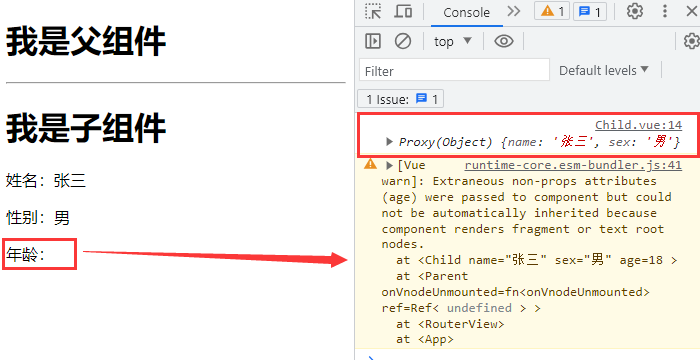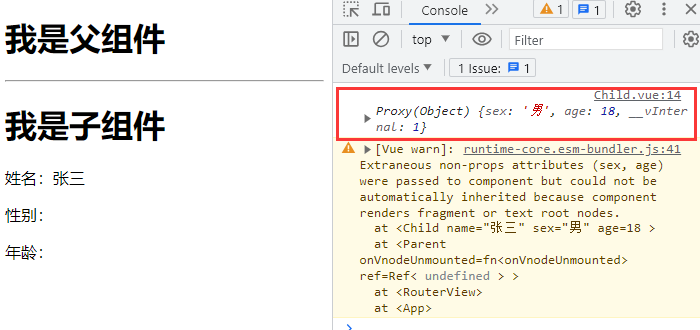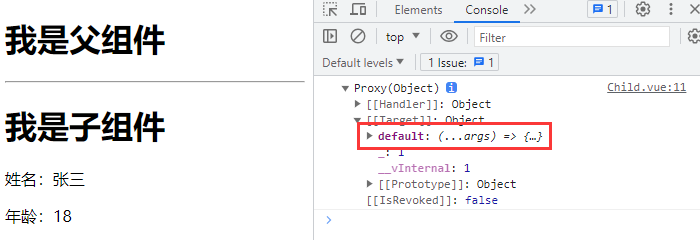已解决
Vue 父子组件传参、插槽
来自网友在路上 174874提问 提问时间:2023-10-31 04:45:45阅读次数: 74
最佳答案 问答题库748位专家为你答疑解惑
setup 函数中有两个主要的参数:props、context 。
props 用于接收父组件传递过来的数据,父传子。
context 指的是 setup 的上下文,它有三个属性:attrs、slots、emit 。
attrs 用于:当父组件传递过来的数据,没有被 props 接收时,数据就会存放在 attrs 属性中。
slots 用于:接收父组件传递过来的插槽内容,相当于 vue2 中的 `this.$slots` 。
emit 用于:创建自定义事件函数,子传父。相当于 vue2 中的 `this.$emit` 。
setup 函数中的 props 参数【父传子】
父组件:
<template><h1>我是父组件</h1><hr /><!-- 3.使用子组件,并通过自定义属性传递数据 --><Child :name="info.name" sex="男" :age="info.age"></Child>
</template><script>
import { reactive } from 'vue';
// 1.引入子组件
import Child from '../components/Child.vue';
export default {name: "Parent",// 2.注册子组件components: { Child },setup() {let info = reactive({name: "张三",age: 18})// 返回数据return { info }}
}
</script>子组件:
<template><h1>我是子组件</h1><p>姓名:{{ props.name }}</p><p>性别:{{ props.sex }}</p><p>年龄:{{ props.age }}</p>
</template><script>
export default {name: "Child",// 接收数据,未接收的数据不会在 props 参数中显示props: ['name', 'sex'],setup(props, context) {console.log(props);// 返回数据return { props }}
}
</script>
效果:

props 参数的几种接收方式
无限制接收:
props: ['name', 'sex', 'age']限制数据类型接收:
props: {name: String,age: Number,sex: String
}限制数据类型、默认值、是否必填接收:
props: {name: {type: String,required: true // 是否必填},age: {type: Number,required: true // 是否必填},sex: {type: String,default: '保密' // 设置默认值}
}context 参数中的 attrs 属性【子传父】
父组件:
<template><h1>我是子组件</h1><p>姓名:{{ props.name }}</p><p>性别:{{ props.sex }}</p><p>年龄:{{ props.age }}</p>
</template><script>
export default {name: "Child",// 假设父组件传递了 name、age、sex 三个数据,props 只接收 name 数据props: ['name'],setup(props, context) {// 那么 props 未接收的数据会在 attrs 属性中显示console.log(context.attrs);// 返回数据return {props}}
}
</script>效果:

context 参数中的 slots 属性【默认插槽】
父组件:
<template><h1>我是父组件</h1><hr /><Child><p>姓名:{{ info.name }}</p><p>年龄:{{ info.age }}</p></Child>
</template><script>
import { reactive } from 'vue';
import Child from '../components/Child.vue';
export default {name: "Parent",components: { Child },setup() {let info = reactive({name: "张三",age: 18})// 返回数据return { info }}
}
</script>子组件:
<template><h1>我是子组件</h1><slot>默认值</slot>
</template><script>
export default {name: "Child",setup(props, context) {// 父组件传递过来的插槽内容,会存放在 slots 属性中console.log(context.slots);}
}
</script>
效果:

context 参数中的 emit 属性【子传父】
父组件:
<template><h1>我是父组件</h1><hr /><!-- 使用自定义事件 --><Child @myEvent="myInfo"></Child>
</template><script>
import Child from '../components/Child.vue';
export default {name: "Parent",components: { Child },setup() {// 接收父组件传递的数据let myInfo = (value) => {alert(`我是父组件,我收到数据了,值为:${value}`);}// 返回数据return { myInfo }}
}
</script>子组件:
<template><h1>我是子组件</h1><button @click="test">往父组件中传递数据</button>
</template><script>
export default {name: "Child",// 声明自定义事件emits: ['myEvent'],setup(props, context) {let test = () => {// 调用自定义事件,语法为:context.emit('自定义事件', 值);context.emit('myEvent', 666);}// 返回数据return { test }}
}
</script>效果:

原创作者:吴小糖
创作时间:2023.10.26
查看全文
99%的人还看了
相似问题
- Tekton — 通过tekton-operator部署tekton组件
- vue3中使用全局自定义指令和组件自定义指令
- HarmonyOS ArkTS 基础组件的使用(四)
- 界面控件DevExpress WPF流程图组件,完美复制Visio UI!(一)
- Vue2系列 -- 组件自动化全局注册(require.context)
- 扩散模型实战(十一):剖析Stable Diffusion Pipeline各个组件
- django DRF认证组件示例
- MySQL内部组件与日志详解
- 前端新手Vue3+Vite+Ts+Pinia+Sass项目指北系列文章 —— 第五章 Element-Plus组件库安装和使用
- 修改el-radio-group样式,自定义单选组件
猜你感兴趣
版权申明
本文"Vue 父子组件传参、插槽":http://eshow365.cn/6-28300-0.html 内容来自互联网,请自行判断内容的正确性。如有侵权请联系我们,立即删除!
- 上一篇: 学习英语1
- 下一篇: Node学习笔记之MongoDB